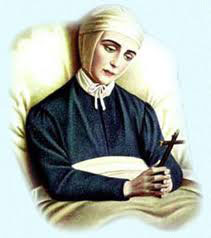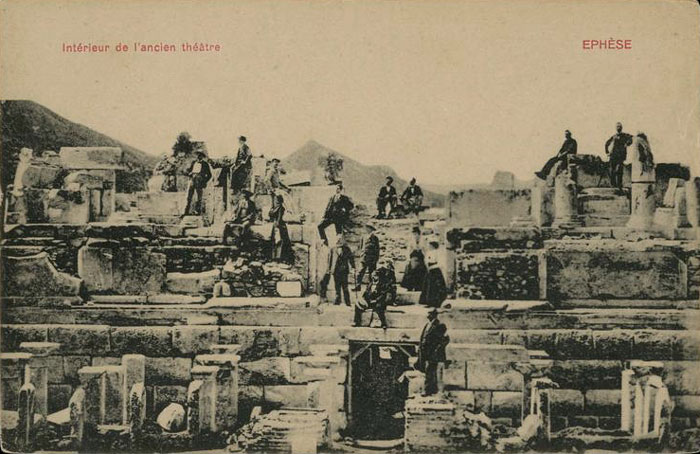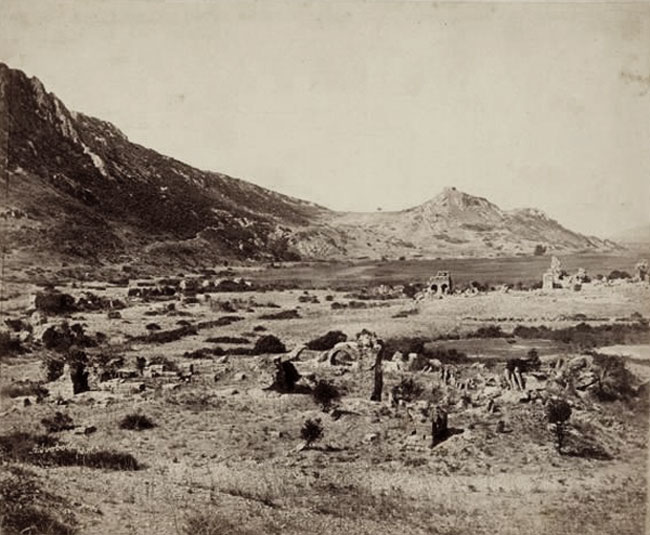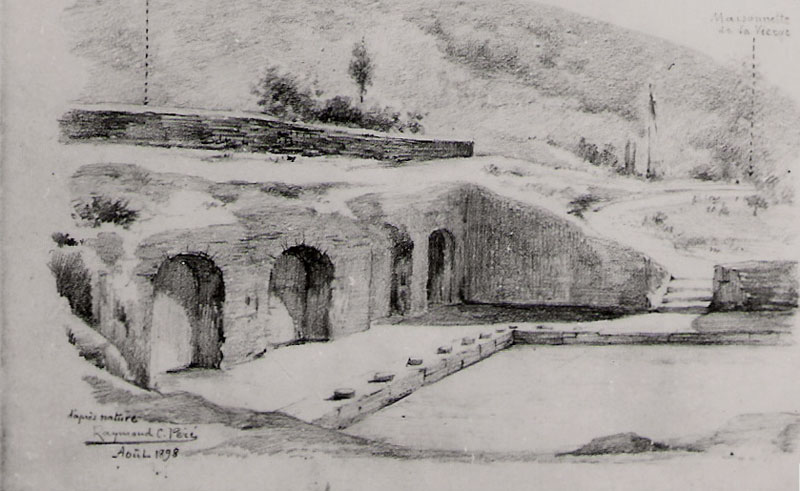With the aid of the revelations of a stigmatized German nun, a French priest found Panaya Kapulu, the house near Ephesus in which many believe the Virgin lived and died.
On the feast of St. Luke, October 181 1881, a humble and scholarly French priest, the Abbé Gouyet of Paris, examined the partially ruined remains of a small stone building he had discovered after three days search in the mountains south of the ancient city of Ephesus in western Turkey. He was accompanied by a native guide. In his hand was a small book in brown leather binding which he frequently consulted in his examination of the building. In his pocket was a letter written for him in Modern Greek by a priest at Smyrna, in case he should be attacked by bandits who were known to make their headquarters in the wild, uninhabited region. The letter stated, “I am a poor priest-religious, I have nothing. I am searching on this mountain for the House of the Most Blessed Virgin. Please allow me to continue my researches.”
Nearly 75 years have passed since that day. Panaya Kapulu—the House of the Virgin—is now a well-known Marian shrine and the scene of a great annual pilgrimage on August 15, the feast of the Assumption. Innumerable persons from all over the world who have visited it—including Catholics, Greek Orthodox and significantly enough, Mohammedans (who also preserve a profound veneration for Our Lady)--believe as the Abbé Gouyet did that it is the actual house where she lived during the last nine years of her earthly existence, that it contains the actual room where she died and that the tomb of her glorious Assumption, as yet undiscovered, will one day be found in the neighborhood.
While no formal declaration on the subject has been issued from the Vatican, at least three modern pontiffs have expressed their personal interest in, and have encouraged devotion to, the little shrine near Ephesus. In 1896 Leo XIII blessed the first Catholic pilgrimage to the site. Pius X (now St. Pius X) granted a plenary indulgence to the pilgrimage of 1914, promised the House of the Virgin the indulgences regularly attached to Holy Places and sent his blessing to "the valiant searchers for the tomb of the Most Blessed Virgin." Our own Pius XII, the Pope of the Assumption, has blessed the pilgrimages during his pontificate. In 1951, the year following the definition of the dogma of the Assumption, he extended to pilgrim priests the privilege of celebrating there the votive Mass of the Assumption at all times.
The authenticity of the so-called “tomb of the Virgin” at Jerusalem has long been questioned by Biblical scholars. Many of them have seen in the relatively recent discovery of Panaya Kapulu an impressive confirmation of the ancient tradition that Mary actually lived her final years on earth at Ephesus. This tradition has been preserved as a living belief in Asia Minor from the earliest times down to the present day and has been supported by a number of distinguished scholars, including the Catholic historian Sebastian Le Nain de Tillemont (1637-1698) and the learned Pope Benedict XIV (pontificate 1740-1758).
The existence of an actual house where Our Lady may have lived, however, was something never anticipated by historians. It could hardly have been dis¬covered on the basis of ordinary Biblical studies. While the Abbé Gouyet was well aware of the scholarship on the subject—he had devoted some 20 years to study of it—he found his principal confirmation, as well as the guide for his unusual archaeological expedition, in a work entitled The Life of the Blessed Virgin. This book is based on the revelations of a stigmatized German nun, the Venerable Anna Catharina Emmerick (1774-1824), who had died in the reputation of sanctity and whose cause for beatification was later to be formally introduced at Rome.
During the last five years of her life, Sister Emmerick’s extraordinar¬ily realistic, historic visions regarding the lives of Christ, His Mother, the Apostles and the history of the primitive Church had been recorded day after day by Clemens Bretano, a celebrated writer of the period, in one of the most extensive documentations of mystical experience ever kept. The immense mass of notes preserved in his journals subsequently had been published in five lengthy volumes entitled The Bitter Passion, The Life of Our Lord and Savior Jesus Christ (three volumes) and The Life of the Blessed Virgin.
The Dead Sea Scrolls, discovered in a series of caves in the Holy Land since 1947, are now recognized by scholars throughout the world as one of the greatest finds ever made in the history of Biblical archaeology. An entire library, dating from the time of Christ and believed to belong to the Jewish monastic order of the Essenes, was found in the caves not far from the ruins of an ancient Essene monastery. The discovery has confirmed the authentic historical character of Sister Emmerick’s revelations describing the Essenes. According to her visions the Virgin Mary (and therefore Christ himself in His human ancestry) was descended through St. Anne from a line of married Essenes. The “Teacher of Righteousness” mentioned in the Dead Sea Scrolls and believed to have lived about 100 B.C. was quite possibly the Essene Charioth, named by Sister Emmerick as a famous member of the order at that period.
The Abbe Gouyet had at first read the Emmerick revelations as a young man of 20, and because of a special circumstance they had made a profound impression on him: He was not a priest at that time and was struggling with serious difficulties and temptations regarding his vocation. One day as he knelt in prayer before the Blessed Sacrament, depressed by his doubts and uncertain¬ties, a scene from the life of Christ as witnessed in a vision by Anna Catharina Emmerick passed through his mind. The scene described Our Lord as He was curing, one day at Capharnaum, a multitude of sick persons, some of whom He passed by and did not cure:
“Many of the latter had previously implored His help and having received it without becoming truly converted had fallen again into their physical and moral miseries. As the Savior was passing before them they cried out: ‘Lord Lord, you are curing all these invalids and forgetting us! Lord, have pity on us, we are sick again! Jesus said to them: Why do you not stretch out your hands to Me?’ Then, as they did stretch out their hands and said: ‘Lord, here they are!’ He replied: ‘Yes, you stretch out to Me the hands of your body but I am unable to grasp those of your heart.’”
Instinctively the young Gouyet found himself adding in prayer: “But I, Lord—it seems to me that it is indeed the hands of my heart that I stretch out to You!” Instantly his interior difficulties disappeared and from that moment he no longer had any doubt or difficulty as to his vocation. Having, as it were, become a priest through the influence of these revelations, he be¬came more and more interested in them and convinced of their divine inspiration.
Because of his special devotion to Our Lady he was particularly interested in what Sister Emmerick had seen regarding the Blessed Virgin. Among her numerous statements on this subject, those that described Mary's last years, death and Assumption at Ephesus attracted his particular attention. After stating that the Blessed Virgin was 64 years old when she died and that she lived for nine years at Ephesus, the stigmatized nun, had included the following remarks, excerpted from the complete and lengthy description in The Life of the Blessed Virgin which runs into some 30 pages:
“Mary did not live at Ephesus itself but in its environs… the place was about three and a half hours’ walk from Ephesus on a mountain towards the left of the road as one comes from Jerusalem…
“When St. John brought the Holy Virgin here to her house, which he had had built in advance, there were already other Christian families and holy women living in the neighborhood… They had come here to escape a violent persecution…
“Mary’s house was the only one built of stone. A short distance behind it the rocky hill rose towards its summit from which, over hills and trees, one could see Ephesus and the sea with its numerous islands. The place here is nearer to the sea than Ephesus. The region is isolated and unfrequented. Nearby is a castle where a deposed king lived; John often went to see him and also converted him…
“Mary’s house was stone, rectangular in shape and, at the rear, round or angled; the windows were high, the roof flat. It was divided in two parts by a centrally located fireplace. The fire faced the door and burned on the earth in a niche built in a wall which rose in steps on both sides of it up to the ceiling… To the right and left of the fireplace one passed through light doors into the rear, darker room, which was very neatly and charmingly arranged… The farthest part of this room, which was round or angled and closed off by a curtain, formed Mary’s oratory… To the right of .this prayer-room, in a niche against the wall, was the sleeping-place of the Holy Virgin and across from it, to the left of the prayer-room, a closet where her cloth¬ing and household equipment was stored." (For a detailed account of Mary’s house and life at Ephesus, her companions, death and Assumption, see volume IV, pp. 449-476, the complete Life of Our Lord and Savior Jesus Christ, based on the revelations of the Venerable Anna Catharina Emmerick, published by the Academy Library Guild, Box 549, Fresno, California).
These words with their exact geographical and architectural clues were the sole guide to the Abbé Gouyet’s discovery of Papaya Kapulu. The circum¬stances of the discoveries (actually there were two) have guaranteed that the building is undoubtedly the one described by Sister Emmerick and which she in¬dicated was still in existence. The original claim made by the Abbé Gouyet in 1881 was at first ignored in official quarters and the source which had been his inspiration was regarded with grave suspicion. The Emmerick revela¬tions were not to be taken seriously, he was told, and were nothing more than a “woman’s dreams.”
Ten years later, however, a similar expedition was made by some Lazarist missionaries from Smyrna with an altogether different objective. Whereas the Abbé Gouyet had had absolute faith in the existence of the house before setting out to find it, the Lazarist Fathers undertook their exploration with the purpose of proving that there was nothing there and so putting an end to the rumors which had lingered on in Smyrna over since Gouyet’s announcement. After three days’ search and using the same source as a guide, they found the same house on July 29, 1891, and were so struck by its correspondence with Sister Emmerick’s description that they whole heartedly changed their opinion and became the shrine’s greatest champions in the years that followed. Gouyet returned to Ephesus and, on the basis of a plan he had drawn in 1881 and the witness of the young man who had accompanied him as a guide, it was established beyond question that the two differently motivated discoveries had coincided.
Perhaps the most remarkable circumstance, however, in this remarkable story of sacred archaeology was that it was learned that the little building already was known and since time immemorial had been venerated by the inhabi¬tants of a nearby mountain village who claimed descent from the ancient Christians of Ephesus. Every year they went with their priest on solemn pilgrimage on the feast of the Assumption. The tradition that Mary had lived and died at Panaya Kapulu, as they called it—a composite Greek and Turkish phrase meaning “the door or house of the Virgin”—had been handed down by them from father to son, unknown to the rest of the world, for as long as they could remember.
The claim of being the actual house where Mary lived distinguishes the House of the Virgin from other centers of Marian devotion. It is not a place of apparitions or miracles or a great modern basilica, like Lourdes and Fatima but a modest three-room dwelling, about 40 feet long by 20 feet wide. The foundations and lower walls are believed by archaeologists to date back to the first century. The original building was apparently enlarged and converted into a chapel during the sixth or seventh century. At that time the present entry was added and the fireplace wall removed. In 1898, however, ‘the floor was examined and beneath it were discovered the original paving stones as well as the hearth, blackened on top by fire and containing some ashes, petrified with age—in exactly the position indicated by Sister Emmerick.
In 1951 the Turkish government built an auto road up to the holy hill. In the same year the Society of Panaya, founded by Msgr. Josef Descuffi, C.M. Archbishop of Smyrna, completely restored the ruins, using ancient building materials and following the indications given in The Life of the Blessed Virgin. With the exception of the closet or storeroom to the left of the oratory, which has long since disappeared because of the action of an under¬ground spring, the rest of the building, as well as its geographical location conforms with astonishing accuracy.
A year ago two members of the Little Brothers of Jesus arrived to serve regularly at the shrine. This is the first time in its history that Panaya Kapulu has had permanent clergy. Monsignor Descuffi said: “We are obliged to build their house on the Holy Hill in order to organize a spiritual station of prayer, penitence and contemplation, and also a home of Eucharistic radiance and religious meditation for the priests, the religious and the pious laity. The Little Brothers live very poorly by their own labor and by tilling the ground, after the manners and customs of the native people.”
From the hilltop behind the house one can see, to the west, the blue Aegean—the "wine dark sea” of Homer- and the peaks of Samos, one of the fabled isles of Ionian Greece. A little farther to the south, but out of sight, lies Patmos, where St. John in exile saw the prophetic vision of the Apocalypse. To the north, below the knees of the holy mountain, lies the marble-strewn plain that was once the great pagan, and later the great Christian, city of Ephesus. Little remains save the massive foundations and fallen columns of the splendid metropolis, in its day the capital city and treasury of all Asia Minor and, with Athens and Jerusalem, one of the three most famous religious centers of the Greco-Roman world.
Here, in the period when the Virgin was still living on earth—and perhaps in this very spot—-a quarter of a million pagans from the lands of the Mediterranean and Asia annually congregated in the month of spring to celebrate a festival at one of the "seven wonders of the world,” the magnificent temple of Artemis or Diana. Here, too, a few years after her death, in the beautiful semicircular theater, the broken stage and the sloping seats of which may still be seen, overgrown with weeds, occurred the riot described in the nineteenth chapter of the Acts of the Apostles. It was this tumult which ended the more-than-two-year Ephesian residence of St. Paul.
Here St. John, the last of the Apostles, lived. He was buried on the hill overlooking Artemis’ Temple. His tomb, now empty, and the magnificent church built over it by the Emperor Justinian, now lying in tragic but noble ruin, were for centuries the goal of Christian pilgrims from Europe. Here, in the year 431 of the Christian era, the third ecumenical council of the Church con¬vened in the oldest basilica known to have been dedicated to the Virgin. The council defined the first Marian dogma, that of the Theotokos or divine maternity of her who was thus Called for the first time, in this city, the Mother of God. Although Mary had been called the Mother of God by the people generally, this was the first time that the Church, as such, officially so saluted her. The Italian government has recently undertaken the restoration; of a part of the basilica. It is hoped that, in about two years, the restored church will once more serve, after a lapse of some 11 or 12 centuries, as a regular Catholic sanctuary.
Perhaps the most significant development for the shrine is the official communication from Archbishop Descuffi of March 10, 1955, regarding a cure he terms miraculous. Mlle. Jeanne Koury, 35, had suffered from Pott's disease since 1950. The disease, characterized with decalcification of two dorsal vertebrae and two ribs, had resisted thorough medical treatment, even a competent operation. By August, 1951, Mlle. Koury’s condition was desperate swelling, severe pain and paralysis of the lower limbs were all apparent. The patient, however, did not cease to pray to the Virgin that she might be cured.
Mlle. Koury’s parents made a pilgrimage to Panaya Kapulu on August 19, 1951, the day of the solemn inauguration of the restored sanctuary. On their return, they sprinkled over their daughter in the form of the cross some water from the spring at Panaya Kapulu. The invalid fell asleep for four hours. Upon awakening, she found herself completely cured. Several physicians who have examined her in the intervening years have acknowledged that this sudden and perfect cure cannot be explained from a medical point of view by any laws of nature that medicine knows to date.
The story of the little house on the mountain overlooking these venerable stones has scarcely begun. Many who are devoted to it are praying that an even greater discovery will soon be made—the tomb of the Assumption. To date it has not been located, though many attempts have been made to find it. Sister Emmerick said:
“Behind the house, a stretch of the way up the hillside, the Holy Virgin laid out a kind of Way of the Cross... Soon after her arrival here in this region I saw her going daily over a part of the way in this meditation on the Passion. At first she went alone and counted the number of steps as she so often had (in Jerusalem) between the points where something particular had happened to the Savior. At each station she erected a stone or, if a tree was standing there, she marked it. The way led into a wood where she indicated Calvary on a hill and the Sepulcher of Christ in a small cave on another hill… to reach the station of the Holy Sepulcher one went over the hill and on the other side came to the memorial stone; still lower, at the foot of the hill, one came to the cave of the Sepulcher in which the Holy Virgin herself was later buried. I believe that this Sepulcher must still exist under the earth and will come to light some day.
 |
 |
 |
 |
Further images of this locality
A 1907 article by the Levantine, William Griffitt Blackler, on this locality.